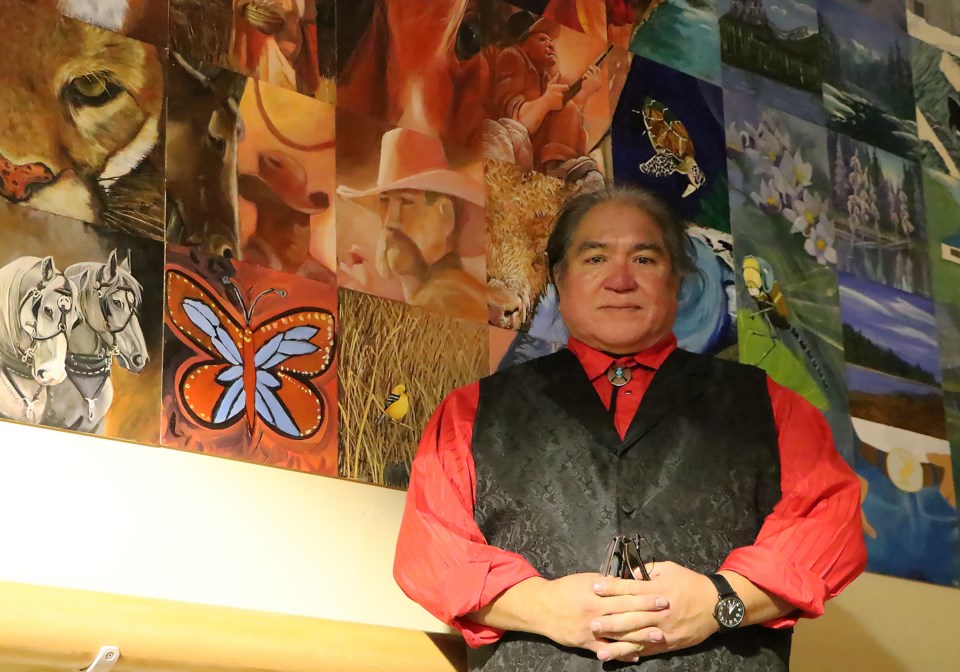BOW VALLEY – Joe Gilchrist’s grandmother used to tell him if you can’t walk on the land barefoot, you know something is wrong.
A forest overgrown and covered in wildfire fuels is unhealthy and hurts to walk on, much like a grassland that’s overdue for a burn and covered in prickly, dead vegetation.
“That forest isn’t healthy, it’s sick. There’s no food for the animals, the predators have lots of places to hide,” he said. “Spiritually speaking, there’s always a battle between the light and the dark. If the forest is dark, it’s because it’s too thick and it hasn’t been looked after.”
Gilchrist is a member of the Skeetchestn Indian Band, part of the Secwépemc Nation in British Columbia. He is a traditional fire keeper with the Interior Salish Firekeepers, a group he co-founded in 2017.
He’s also a former firefighter who served with the B.C. Wildfire Service in the 1980s and worked on FireSmart programs with the province’s ministry responsible for forestry in the ‘90s.
Gilchrist, who spoke at a recent event titled Living in the Natural Environment, sponsored by the MD of Bighorn, emphasized the importance of Indigenous fire keeping practices and advocated for cultural burns as a means to combat wildfires.
In essence, it means fighting fire with more fire.
Cultural burning, practiced by Indigenous peoples and passed down through generations for thousands of years, is a controlled application of fire on the landscape to fulfill cultural objectives, like food and medicinal plant revitalization, habitat enhancement, fuel mitigation and language preservation.
In the Secwépemctsín language, Gilchrist said elders and language advisory committees have so far tallied 75 different ways the word ‘fire’ is used.
“I would bet that different Indigenous groups across Turtle Island with different languages have many of their own words for the use of fire because it was used not only in North America, but South America, Australia and Africa. Fire was used by Indigenous peoples and so their languages would reflect that,” he said.
Cultural burns, guided by elders or fire keepers, are typically low-intensity, done at times of the year when it’s safe to do so and, these days, often involves collaboration with government partners.
The Interior Salish Firekeepers aim to normalize cultural burning by advocating for regulatory reforms on reserves and traditional lands of Indigenous peoples. The group is comprised of hunters, medicine people, firefighters and others.
Gilchrist said the B.C. government relegates burning only on reserve lands and not traditional lands. The same goes for the rest of Canada.
The practice of cultural burning was outlawed in B.C. in 1874 and the rest of Canada followed course in the early 1900s.
But while burning became more difficult, it didn’t stop with the arrival of settlers.
“We burned in the springtime or in the fall,” said Gilchrist. “We would burn to reduce the denseness of a forest, to expose the soil, to bring up mushrooms and all different kinds of medicines.”
It was also common practice in his community to burn around stagnant water bodies to produce smoke and manage mosquito populations, he said.
There are many goals to cultural burning that vary by Indigenous groups, but like the national FireSmart program, the aim is to protect communities by decreasing surface fuels to slow the spread of wildfire.
There has been some cooperation between different levels of government to move the needle on bringing cultural burning back, Gilchrist said, but progress has been slow at a time when wildfire risks are increasing with climate change.
In 2023, Alberta endured an unprecedented wildfire season, scorching over 2.5 million hectares of land, evacuating more than 38,000 people from their homes. In B.C., more than 2.84 million hectares was burned and 10’s of thousands of people were forced to evacuate. The wildfire season also killed six firefighters in B.C.’s wildland firefighting community.
Nationally, Canada experienced a historic wildfire outbreak, with more than 6,100 fires consuming a record-breaking 17.5 million hectares in 2023.
Gilchrist noted the cost to suppress wildfires is reaching record-breaking amounts, as well. Last year, B.C., Alberta, N.W.T and Saskatchewan spent over $1.4 billion on fire suppression. The fire keeper argued this figure could be significantly less with more inclusive and efficient regulations around cultural burning to help periodically clear forests, grasslands and other landscapes home to Indigenous peoples of surface fuels that cause more high-intensity wildfires.
“This way that Indigenous peoples have been using fire for thousands of years is a new way to go forward,” said Gilchrist.
“It means better long-term planning for generations that aren’t even born yet. We need forest management practices to catch up, we need to consider other preventative measures to keep wildfires from becoming catastrophic. Fighting fire with fire and letting nature run its course, at least in some cases, is going to be increasingly crucial.”
The Local Journalism Initiative is funded by the Government of Canada. The position covers Îyârhe (Stoney) Nakoda First Nation and Kananaskis Country.



